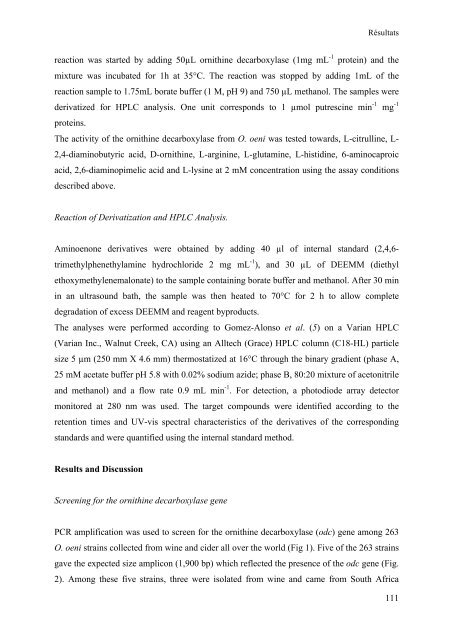THESE Maryse Bonnin Jusserand - Université de Bourgogne
THESE Maryse Bonnin Jusserand - Université de Bourgogne
THESE Maryse Bonnin Jusserand - Université de Bourgogne
Create successful ePaper yourself
Turn your PDF publications into a flip-book with our unique Google optimized e-Paper software.
Résultats<br />
reaction was started by adding 50µL ornithine <strong>de</strong>carboxylase (1mg mL -1 protein) and the<br />
mixture was incubated for 1h at 35°C. The reaction was stopped by adding 1mL of the<br />
reaction sample to 1.75mL borate buffer (1 M, pH 9) and 750 µL methanol. The samples were<br />
<strong>de</strong>rivatized for HPLC analysis. One unit corresponds to 1 µmol putrescine min -1 mg -1<br />
proteins.<br />
The activity of the ornithine <strong>de</strong>carboxylase from O. oeni was tested towards, L-citrulline, L-<br />
2,4-diaminobutyric acid, D-ornithine, L-arginine, L-glutamine, L-histidine, 6-aminocaproic<br />
acid, 2,6-diaminopimelic acid and L-lysine at 2 mM concentration using the assay conditions<br />
<strong>de</strong>scribed above.<br />
Reaction of Derivatization and HPLC Analysis.<br />
Aminoenone <strong>de</strong>rivatives were obtained by adding 40 µl of internal standard (2,4,6-<br />
trimethylphenethylamine hydrochlori<strong>de</strong> 2 mg mL -1 ), and 30 µL of DEEMM (diethyl<br />
ethoxymethylenemalonate) to the sample containing borate buffer and methanol. After 30 min<br />
in an ultrasound bath, the sample was then heated to 70°C for 2 h to allow complete<br />
<strong>de</strong>gradation of excess DEEMM and reagent byproducts.<br />
The analyses were performed according to Gomez-Alonso et al. (5) on a Varian HPLC<br />
(Varian Inc., Walnut Creek, CA) using an Alltech (Grace) HPLC column (C18-HL) particle<br />
size 5 µm (250 mm X 4.6 mm) thermostatized at 16°C through the binary gradient (phase A,<br />
25 mM acetate buffer pH 5.8 with 0.02% sodium azi<strong>de</strong>; phase B, 80:20 mixture of acetonitrile<br />
and methanol) and a flow rate 0.9 mL min -1 . For <strong>de</strong>tection, a photodio<strong>de</strong> array <strong>de</strong>tector<br />
monitored at 280 nm was used. The target compounds were i<strong>de</strong>ntified according to the<br />
retention times and UV-vis spectral characteristics of the <strong>de</strong>rivatives of the corresponding<br />
standards and were quantified using the internal standard method.<br />
Results and Discussion<br />
Screening for the ornithine <strong>de</strong>carboxylase gene<br />
PCR amplification was used to screen for the ornithine <strong>de</strong>carboxylase (odc) gene among 263<br />
O. oeni strains collected from wine and ci<strong>de</strong>r all over the world (Fig 1). Five of the 263 strains<br />
gave the expected size amplicon (1,900 bp) which reflected the presence of the odc gene (Fig.<br />
2). Among these five strains, three were isolated from wine and came from South Africa<br />
111

















